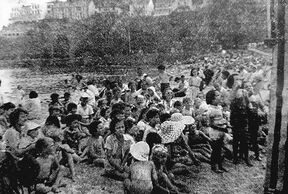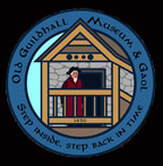Looe Old Guildhall Museum and Gaol
Punch & judy

Punch & Judy
The museum’s set of wooden Punch & Judy puppets were made in Germany, probably in the late 1800s. Sometimes known as Charivari puppets after the French word for a loud, riotous parade, used to shame or punish wrongdoers. In England, the act of Charivari is sometimes known as Rough Music. An example from 1860 tells of a noisy chant being used against a man who had ill-treated his wife..
Has beat his wife!
It is a very great shame and disgrace
To all who live in this place
It is indeed upon my life!
Of course the traditional Punch & Judy shows centre around the ‘naughty Mr Punch’ who beats his wife and baby, along with the crocodile, policeman and anybody else who comes before him. Over the years the story has changed or been toned down as audiences have got younger. Before the 20th century, most shows were put on for adults, but once children became the prime audience, characters like the Devil and ‘Pretty’ Polly, Punch’s flirty mistress, disappeared from the story. In recent times, it is rare for the hangman to appear as the sight of Mr Punch dangling from a rope is no longer considered suitable for a young audience.
The museums traditional Punch and Judy characters were not sold to be used by professional puppeteers, rather to be used by children and may have even had a pop up theatre included in the set. Alongside Punch and Judy we have the Policeman, Joey the Clown, a Clergyman, the Judge and the Beadle. Sadly, not all of our figures are in their original costumes.
In the 1960’s a Punch & Judy man would regularly do a show on East Looe beach, he would promote the shows by walking around the beach on stilts.
Did you know?
The early editions of Punch magazine, first published in July 1841, was subtitled The London Charivari, in homage to a French satirical humour magazine called Le Charivari.
The museum’s set of wooden Punch & Judy puppets were made in Germany, probably in the late 1800s. Sometimes known as Charivari puppets after the French word for a loud, riotous parade, used to shame or punish wrongdoers. In England, the act of Charivari is sometimes known as Rough Music. An example from 1860 tells of a noisy chant being used against a man who had ill-treated his wife..
Has beat his wife!
It is a very great shame and disgrace
To all who live in this place
It is indeed upon my life!
Of course the traditional Punch & Judy shows centre around the ‘naughty Mr Punch’ who beats his wife and baby, along with the crocodile, policeman and anybody else who comes before him. Over the years the story has changed or been toned down as audiences have got younger. Before the 20th century, most shows were put on for adults, but once children became the prime audience, characters like the Devil and ‘Pretty’ Polly, Punch’s flirty mistress, disappeared from the story. In recent times, it is rare for the hangman to appear as the sight of Mr Punch dangling from a rope is no longer considered suitable for a young audience.
The museums traditional Punch and Judy characters were not sold to be used by professional puppeteers, rather to be used by children and may have even had a pop up theatre included in the set. Alongside Punch and Judy we have the Policeman, Joey the Clown, a Clergyman, the Judge and the Beadle. Sadly, not all of our figures are in their original costumes.
In the 1960’s a Punch & Judy man would regularly do a show on East Looe beach, he would promote the shows by walking around the beach on stilts.
Did you know?
The early editions of Punch magazine, first published in July 1841, was subtitled The London Charivari, in homage to a French satirical humour magazine called Le Charivari.

The Old Guildhall Museum and Gaol is run by East Looe Town Trust
The Guildhall
Fore St
East Looe
Cornwall
PL13 1AA
Tel: 01503 263709
e-mail: [email protected]
www.eastlooetowntrust.co.uk
Proudly powered by Weebly